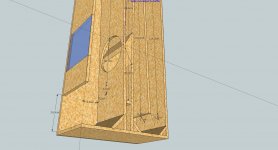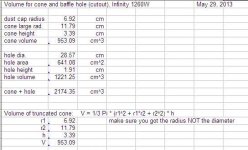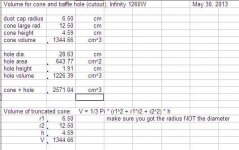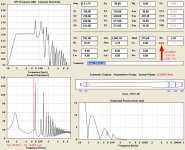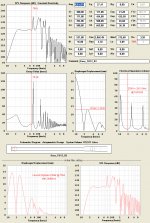Hi kees52,
That sure looks tight. I would be nice to have a cross-sectional drawing through the middle of your driver (e.g.: http://www.diyaudio.com/forums/subwoofers/228434-mth30-questions-complete-noob-18.html#post3364397 Post #175).
Check your numbers one more time, e.g.: in Post #4089 you have a Hornresp Input of S4=830cm^2, and drawing dimensions for the mouth of 33.3cm x 26.7cm, which equals S4=889.11cm^2. I know that particular one does not make any real difference, but it should be corrected anyhow.
Regards,
That sure looks tight. I would be nice to have a cross-sectional drawing through the middle of your driver (e.g.: http://www.diyaudio.com/forums/subwoofers/228434-mth30-questions-complete-noob-18.html#post3364397 Post #175).
Check your numbers one more time, e.g.: in Post #4089 you have a Hornresp Input of S4=830cm^2, and drawing dimensions for the mouth of 33.3cm x 26.7cm, which equals S4=889.11cm^2. I know that particular one does not make any real difference, but it should be corrected anyhow.
Regards,
Hi kees52,
That sure looks tight. I would be nice to have a cross-sectional drawing through the middle of your driver (e.g.: http://www.diyaudio.com/forums/subwoofers/228434-mth30-questions-complete-noob-18.html#post3364397 Post #175).
Check your numbers one more time, e.g.: in Post #4089 you have a Hornresp Input of S4=830cm^2, and drawing dimensions for the mouth of 33.3cm x 26.7cm, which equals S4=889.11cm^2. I know that particular one does not make any real difference, but it should be corrected anyhow.
Regards,
Hi TB
I had forgotten to correct that, thanks for bringing it to my attention, I don,t like the delete thing in sketchup, it delete sometimes to much and delete a little line across a panel do also delete so that it become hollow, troublesome so to speak but maybe I do now not everything about sketchup.
S4 is now correct, and I hope you do mean this if you ask for the cross sectional, I can not yet drawn a speaker in sketchup, it needs some more practice.
If I remember from long ago a frontloaded basshorn has also some like I did a wig solid connected but in that time I did not now what it was, I do see now however that box building is more complicated then build a very good amp
regards kees
Attachments
Last edited:
Hi kees52,
From pictures and the basic dimensions in the data sheet I took a guess at what a cross-sectional drawing might look like, and I end up with 107.2cm^2 for the cone plus the baffle hole @ S2. Can you verify the dimensions on the driver you have at hand?
Regards,
From pictures and the basic dimensions in the data sheet I took a guess at what a cross-sectional drawing might look like, and I end up with 107.2cm^2 for the cone plus the baffle hole @ S2. Can you verify the dimensions on the driver you have at hand?
Regards,
Attachments
Hi kees52,
From pictures and the basic dimensions in the data sheet I took a guess at what a cross-sectional drawing might look like, and I end up with 107.2cm^2 for the cone plus the baffle hole @ S2. Can you verify the dimensions on the driver you have at hand?
Regards,
Hi
I get from your 107,2 square cm 1109.9 cc while I get 2800 cc (filling cone and cutout with rise) so I am curieus agout your calculation because Djim has also tell me about the cone compensation, the real cone form is no ideal for sim programs, of something of that kind.
Your outcome however is a lot more easy to implement whithout the problem that compression get,s higher or a acoustical narrowing, (the good words?) what Djim did mention.
I have measure my cone with rise, but I thnk already that this is not a waterproof methode. What kind of autocad do you use? I see you are good with it.
I will measure the woofer tomorrow, I let you now.
regards
lees
Last edited:
Hi Kees52,
Your rise method might have pushed the cone downwards under the weight of the rise.
A standard 12" cone usually needs around 80cm^2 at S2, so TB46's estimation of 107,2 cm^2 looks reasonable to me, considering the inverted dome structure. Make sure you measure accurately the distances for TB46.
Your rise method might have pushed the cone downwards under the weight of the rise.
A standard 12" cone usually needs around 80cm^2 at S2, so TB46's estimation of 107,2 cm^2 looks reasonable to me, considering the inverted dome structure. Make sure you measure accurately the distances for TB46.
Last edited:
Hi kees52,
Post #4104: "...I get from your 107,2 square cm 1109.9 cc..."
For the cone plus the cutout volume I calculate 2174 cm^3 (again, that is from my guessed dimensions).
Filling the cone with rice is a good way to get the volume, provided, that you lock the cone in place.
I'll adjust my drawing to your measured dimensions, and will let you know what I would suggest.
Regards,
Post #4104: "...I get from your 107,2 square cm 1109.9 cc..."
For the cone plus the cutout volume I calculate 2174 cm^3 (again, that is from my guessed dimensions).
Filling the cone with rice is a good way to get the volume, provided, that you lock the cone in place.
I'll adjust my drawing to your measured dimensions, and will let you know what I would suggest.
Regards,
Attachments
Hi Kees52,
Your rise method might have pushed the cone downwards under the weight of the rise.
A standard 12" cone usually needs around 80cm^2 at S2, so TB46's estimation of 107,2 cm^2 looks reasonable to me, considering the inverted dome structure. Make sure you measure accurately the distances for TB46.
Hi Djim
I will study it what Tb46 did give, this guy helps me also very good thanks.
in the meantime I did do a new rise measurement that is for cone alone and together with surround and cutout.
I have block the cone. So it did not sink under the weight of the rise, also I told him, rise my son.
Oke serieus, I can measure another time with rise this time only the cone itselfs, I did measure the whole speaker incl the cutout hole in the wood, that give 2,8 liters.
Hmm I did it again and now I got 1380 ml/grams for the speaker full met rise incl suround, and 28,2 cutout is 1111 ml/grams total 2491 ml = 2,491 liter, this is smaller then the first attemt, and so the cone is going more down under weight of the rise, this time I have block the cone again, now it did work.
I can make the correction volume 321 ml smaller, at least better for prevent acoustic block.
update
I did calculate the liters from the square cm, 107,2 en came out with 1,109 liters, I have measure with rise the cone, came
to 900 ml or 0.9 liters so that is close, but I miss then the cutout what to do with that? with cuout see above.
regards
kees
Last edited:
Hi kees52,
Post #4104: "...I get from your 107,2 square cm 1109.9 cc..."
For the cone plus the cutout volume I calculate 2174 cm^3 (again, that is from my guessed dimensions).
Filling the cone with rice is a good way to get the volume, provided, that you lock the cone in place.
I'll adjust my drawing to your measured dimensions, and will let you know what I would suggest.
Regards,
Hi TB46
That is right I get when fill the cone complete to the edge of speaker (what is high but will compress when bold to the baffle) 1,38 liter for the speaker alone, the cutout I get 1,111 liters make a total of 2,491, (this time with proper locket cone).
when measure the cone alone I get 0,9 liters and with 1,111 liters this make 2,011 liters and so your idea,s make sense, the ring around the speaker for cut off air leaks is pretty high for this woofer and will be compressed when bold making less volume.
I go saw the baffle and make a cutout enput the woofer on, this way I get precise that what I want and I think it will be close to you guys,.
thanks for the thoughts.
kees
Hi Tb46
I have measure all, the measurements with a ? on the end is variable by 4 a 6 mm smaller (rubber between speaker edge and bold holes when tight the bolds).
And so I go let saw a baffle for cutout then I get precise value,s for volume (height bolding)..
tb46 myself
148,4 = 146
163,5 = 171?
285,7 = 287
314,3 = 312
128 = 125
33,9 = 45,9?
11,2 = 16?
29,1 = 29,5
277,9 = 280,1
This is what I get.
regards
kees
I have measure all, the measurements with a ? on the end is variable by 4 a 6 mm smaller (rubber between speaker edge and bold holes when tight the bolds).
And so I go let saw a baffle for cutout then I get precise value,s for volume (height bolding)..
tb46 myself
148,4 = 146
163,5 = 171?
285,7 = 287
314,3 = 312
128 = 125
33,9 = 45,9?
11,2 = 16?
29,1 = 29,5
277,9 = 280,1
This is what I get.
regards
kees
Last edited:
Thanks TB 46
One thing I do not shure off, the ring in the speaker who cut off the air leaks, in your drawn the smal blue square who do make the height of the speaker on baffle.
this is some kind of paper or rubber who wil be compressed when tight the loudspeaker bolts 8x, it can therefore make that the 16 mm be 11 mm , that means a change.
I have saw the baffle board I go mount the speaker on it tighten it and measure that again, also I do then the rise test.
The hole in the baffle is 28,2 cm as producer advise.
Nice work of you thanks, ps I did see that I came closer..
regards
kees
One thing I do not shure off, the ring in the speaker who cut off the air leaks, in your drawn the smal blue square who do make the height of the speaker on baffle.
this is some kind of paper or rubber who wil be compressed when tight the loudspeaker bolts 8x, it can therefore make that the 16 mm be 11 mm , that means a change.
I have saw the baffle board I go mount the speaker on it tighten it and measure that again, also I do then the rise test.
The hole in the baffle is 28,2 cm as producer advise.
Nice work of you thanks, ps I did see that I came closer..
regards
kees
Hi kees52,
At least we are getting closer now.Taking your measurements of the driver I end up w/ the following:
Regards,
Hi TB46
The baffle thickness and speaker seal ring is a lot thinner after tighten the bolds, ( it compresses).
Now I measure 1,8 cm wood plus 0,9 cm of speaker ring height makes total 2,7 cm. you did fill in 1,9 cm wood thickness this we don,t have in holland, here it is 1,8, 2,2, 2,5 etc.
the speaker volume is 2512 cc plus minus 50 cc (measure with rise).
regards
kees
Hi kees52,
That's about the same that I came up with:
Regards,
Hi Tb46
Yes nu are we where we want to be.
Djim dis also help a lot, hee give a other way of
make the box, smaller and wider bandwidth, nice to test.
thanks
kees
Hi kees52,
What does the "other way" look like?
Regards,
Like this, nice idea, but I need not exp, but uni.
did that and it is as good, looks like a tapped T-TQWT
combination, Djim has big knowledge about speaker
stuff.
regards
kees
Attachments
Hi Kees,
I just copied your values of the driver, but it looks like the Le should be 2,89 mH. This will change a lot. Not sure where you got the other value from.
I did mail, it is a series inductor for taming the respons like in the lab 12, from where I dit start. also she did
include the induction in hornresp, so if it is a error or make it fail I like to now.
http://www.diyaudio.com/forums/subwoofers/143714-lab12-tapped-horn.html
regards
kees
Last edited:
Hi Kees,
I wouldn't use the value of the external inductor to correct the speaker induction. To simulate such external inductor David has included a filter-wizzard (under tools).
In the attachment you can see an updated example of a sim with driver values as given by the manufacturer.
I wouldn't use the value of the external inductor to correct the speaker induction. To simulate such external inductor David has included a filter-wizzard (under tools).
In the attachment you can see an updated example of a sim with driver values as given by the manufacturer.
Attachments
- Home
- Loudspeakers
- Subwoofers
- Collaborative Tapped horn project
